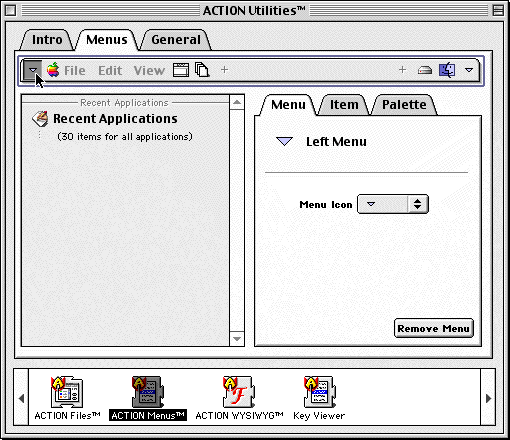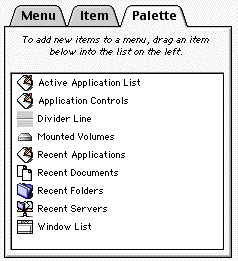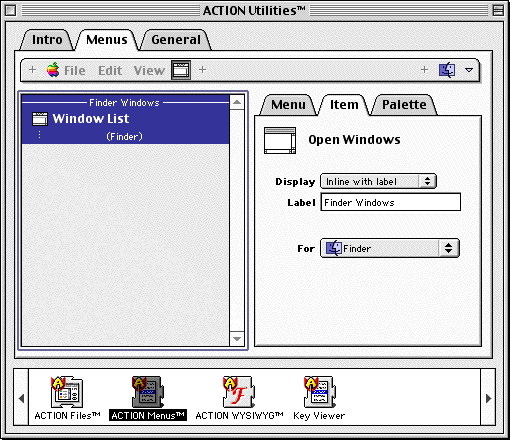|
||||
Action Menus part IIWritten and published February 9, 2000 Last week I introduced you to custom keyboard shortcuts ala Action Menus. This week we look at custom menus. If you missed last week's column, you might want to check it out. It introduces Action Menus and provides the URL so you can download the program and try it out. Adding new menusEver wish you could have your own menu? One that does just what you want it to? You can ... pretty much, at least. That's one of the things Action Menus can do for you. In a while I'll show you how, but first, some scenarios. You've got a page or two open in say, Word or AppleWorks, you've got there site pages open in a browser, and also have your contact manager open, although it's rather small and in a corner. Somewhere in the center of your desktop you've got a folder open - and you want to get to it now. How? Without Action Menus, you have to hide each of the applications that have windows open or collapse (Window shade) all the windows. The fast Finder way to do that is to press Option as you click the collapse box of any of the windows. That'll collapse all of them. But we're talking about Action Menus here so ... With Action Menus, one way is to use the Application menu->Show Finder Only command that I mentioned last week. But, this time you also want to see the documents you have open and forefront on your screen, rather than hide them. The other way is to go to a menu that lists all open windows and choose the open window to simply bring the window forward. If you're a fan of the Recent Items feature, you will probably appreciate Action Menus Recent Items feature. Instead of having Recent Items in your Apple menu where it can be a pain as you select other things from that menu, you can have a dedicated menu. Within that menu, you can have tons of recent items. Of course if your files are well organized you're not highly dependent upon recent items, but the feature can help get back to a document at times. Nuts & BoltsWhen you first install Action Menus a bunch of strange menus are added to your screen. Each provides a different function. You can keep, remove or alter the content of any menu. First, explore each menu to see what each is doing. Go to your Apple menu, choose the Action Utilities Control Panel, then click the Action Menus icon at the bottom. Now that you're in the Action Menus controls, click the Menus tab at the top. At the top of this area, you'll see a depiction of all of your menus. Click one to learn about it (or alter it). In the screen shot below, the left-most arrow-iconed menu is clicked on and being inspected. The rest of the control panel area tells you about the menu. On the left, you can see what that menu does. Soon you'll see how to change those things -- but first click on each new menu to learn about it. After you do that, read on, keeping this control panel as described in this paragraph.
Deleting a menuAre you ready to make some changes? Lets say you don't want to have the extra menu to the left of the Apple menu. To delete that menu, click on it. No matter which tab of the Control Panel, you're in, you'll be snapped back to the Menu tab. Before you actually delete it, note what that menu provides, in case you want to give another menu that functionality. To remove this menu, simply click the Remove Menu button. Customizing a menuSince you already have many menus, it makes sense to remove those you don't want, then customize the ones you want to keep. Then, you can add menus as desired. Select the menu you'd like to keep, but alter.
You can have several functions in each menu if you'd like. Play around trying the various items and settings. You can't lose any information and can't do any harm. As you work in the control panel you'll see your changes on your screen. What can you add? From top to bottom, per the Palette (screen shot below): Active Applications -- shows you what's running, just like the normal Applications menu. Application Controls -- this is the show and hide stuff. The program automatically puts this group of commands at the top of your Applications menu in place of the Finder's similar defaults. You can choose which of this group of items you want to keep by using the Item tab described soon. Divider Line -- this adds a divider line in a menu to help you group things. Mounted Volumes -- provides a list of any other hard drives, partitions, and removable drives available on your desktop. The option (under Items) to show the hard drive contents gives each volume a submenu listing all the volume's contents. Recent Applications -- lets you go back to any application you've recently run. It's similar to the feature the Finder gives you by default under the Apple menu. However, this function lets you have all recent apps listed or lets you see just the recent apps for whatever program is currently running. Recent Documents -- like the recent applications, but shows you the actual documents you've recently run. Recent Servers -- also like the recent applications, but shows you the servers you've recently run. If you don't use File Sharing you don't need to worry about this one. Window List -- shows you a list of any windows that are open on your desktop. Tabbed folders count as open.
Some of the functions you can add are already part of the Finder -- for example, the Active Applications list. So why does Action Menus let you add this stuff? Because it lets you add these things to any menu, anywhere in your menu bar. If you don't like going to the far right of your screen to access the Active Applications, now you can have them appear to the left of the Apple menu or to the left of the Help menu. One thing that bugs me about the Finder's Recent Items feature is that it tracks items by creating aliases. Therefore, when you do a find for an item that recent alias is among the found. And if you accidentally trash stuff and try to do a recovery, the recovery tool has to find and list all those aliases. Recently this happened to someone and recovering those aliases was a tease or taunt because the real items couldn't be recovered. Power On Software uses some other kind of intelligence so we're not plagued by aliases when we take advantage of the recent items features. (It uses a database system and places the info in a folder called Recent Items Database within the Power On Preferences folder in your Preference folder in the System folder). Of course, you can customize many of the menu items after you add them to your menu. With the item selected, switch to the Item tab to see and set the options available for that function. In the Item tab, you'll notice the option to place favorites within some of the menus. This is another quick way to get to things your use the most. To tell Action Menus that a document, application, or server is a favorite, move your mouse to it when it appears in the list, then, while keeping the mouse down so the item remains selected, press the space bar. By default a diamond denotes a favorite, but you can also change that within the Items tab. You can place favorites at the top of a listing, at the bottom, or in regular order along with the other items. Adding a menuTo add menus just click the Plus button in the Control Panel. The changes you make in the Control Panel are seen immediately on your screen -- even while the Control Panel is still open. (A very cool and helpful feature.) To add a menu:
1. Click the Plus button Noticing your changes Want to see how that menu looks without Action Menus? Go to the Intro tab at the very top of the Control Panel (while Action Menus is selected at the bottom of the Control Panel) and click "off". Review
Remember the scenario at the start of this column? The one where you can bring an open folder forward in front of your documents? The following screen shot shows you how to set this up.
A word about the Apple MenuWhen I first started this column, I went into great detail about organizing the Apple menu. But when you install Action Menus some of this menu's order gets messed up. Go ahead and organize it as you like using Action Menus. When the time comes that you have to start with extensions off the old order you worked out will still be there. That way you'll still be able to find your things. Amendment to last week: Preventing further changes I should have mentioned this last week while talking about shortcuts. After you set up all of your desired keyboard shortcuts, you might want to prevent other users from changing them on you. To do so, open the Action Utilities Control Panel, choose Action Menus, then click the General tab. Under Command key assignment, you'll see three options; Select Off to stop others from reassigning commands or adding new ones. A user that has access to the control panel can still turn it back on, but with this feature off users can't accidentally change things. Allow custom menus only, by the way, lets you assign shortcuts to the Action Menus menus but not to the Finder or Application menus. Until Next WeekWell, that's the basics of Action Menus. Give it a shot and read the excellent PDF manual that comes with it. If you're using Action Menus and have a great shortcut or menu setup to share with your fellow MacCentral readers, I'd love to hear from you.
Also, if there's a utility you wish someone would invent, whether it's a small feature or something major, feel free to let me know. If its something AppleScript can do, perhaps our own Bill Briggs will be able to create it for you. If its something major perhaps, I can find a utility programmer to create it. There's something really cool about seeing your wished for product happen. |
||||


